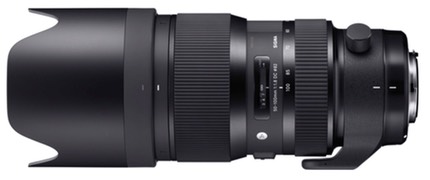(news & commentary)

I guess Sigma’s been reading my complaint about lack of DX lenses. Today they surprised a lot of people by getting back into the crop sensor telephoto range in an interesting and exciting way: the 50-100mm f/1.8 DC HSM Art lens.
Other attributes you want to note about the lens are its use of HSM (fast in-lens autofocus motor), and 82mm front filter size. It’s not particularly a close focusing lens at 3 feet (.95m) and a maximum magnification ratio of 1:6.7, but that’s not likely going to be a big detriment to most people considering this new option.
This new lens gives the DX community a 75-150mm effective zoom. Not quite a 70-200mm equivalent at the long end, but it does grab back the stop of light loss that the smaller crop sensor experiences compared to full frame (all else equal). Still, I wonder if that missing 200mm (effective) at the long end will have an impact on how people view this lens.
The 50-100mm f/1.8 also seems a bit of a pug. While it’s a bit shorter than the Nikkor 70-200mm f/4, it’s bulkier in diameter and about 50% heavier. That said, it seems fairly perfectly matched for a Nikon D500 (and Canon 7DII for that matter, as it comes in EF-S mount, too). Moreover, Sigma has the very sharp 18-35mm f/1.8 zoom for crop sensors already on the market, giving Sigma a two zoom set that takes you from about 28-150mm effective in two fast aperture lenses. (Boy could we use that 16mm or other wide DX prime, buzz buzz.)
If this new Sigma zoom is as good optically as its shorter companion, it’s likely to prove popular with D500 purchasers, I think. But will DX users embrace Sigma’s out-of-the-box focal length/aperture thinking? So many folk are locked into old film-era thinking that lenses like the 18-35mm and now 50-100mm f/1.8 give them pause. They shouldn’t, though the focal length gap between these two does come at a position that some will find a bit problematic (normal to short telephoto). Plus you still don’t have 24mm equivalent in the kit without another lens (and what lens would that be, guys? buzz, buzz).
I applaud Sigma for being creative here. We need more DX appropriate lenses, and this new one seems very DX Pro appropriate on paper. Let’s hope it delivers when we examine the bits off the sensor.
Correction: an earlier version of this article mentioned OSS, which isn’t in the lens.
Support this site by purchasing from this advertiser:





